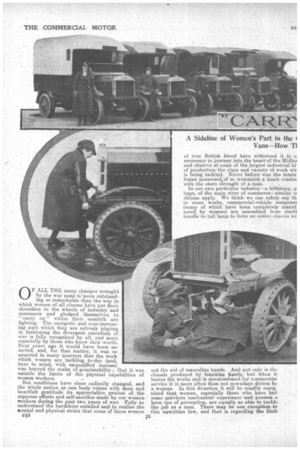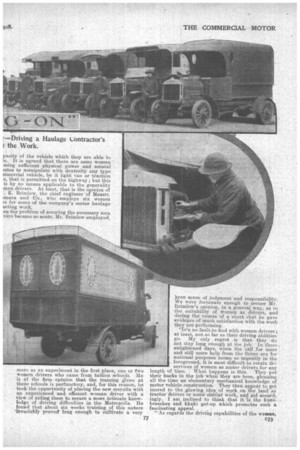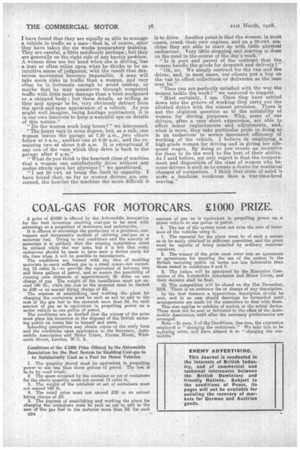A Sideline of Women's Part in the
Page 10

Page 11

Page 12

If you've noticed an error in this article please click here to report it so we can fix it.
7—Driving a Haulage Contractor's the Work.
Vans—How TI
F ALL THE many changes wrought by the war none is'inore outstand ing or remarkable than the way in which women of all classes have put their shoulders to the wheels of industry and commerce •and pledged themselves to " carry on" whilst their menfolk are fighting. The energetic and ever-increasing part which they are actively playing in fashioning the divergent essentials of war is fully recognized by all, and more especially by those who know their worth. Four years ago it would have been asserted, and, for that matter, it was so asserted in many quarters that the work which women are tackling to-day (and, bear in mind, with unqualified success) was beyond the realm of .practicability; that it was outside the limits of the physical capabilities of women workers.
But conditions have since radically changed, and. the whole nation as one body voices with deep and heartfelt gratitude its appreciative ,praises of the supreme efforts and self-sacrifice made by our women workers during the past two years of war. Fully to understand the hardships entailed and to realize the rental and physical strain that some of these women C32 of true British blood have withstood it is o: necessary to journey into the heart of the.Midlai and observe at some of the largest industrial hi' of production the class and variety of work wh: is being tackled. Never before was the femin: frame possessed of so womanish a heart combir with the stern itrength of a man. In our own particular industry—a tributary, p haps, of the main river of commerce—similar c( ditions apply. We think we can safely say th iii some works, commercial-vehicle compone] (many of which have been completely manuf. tured by women) are assembled from ,starti handle to tail lamp to form an entire chassis wi out the aid of masculine hands. And not only is the chassis produced by feminine hands, but when it leaves the works and is commissioned for commercial service it is more often than not nowadays driven, by a woman. In this direction it will be readily recognized that women, especially those who have had some previous mechanical experience -and possess a keen eye of perception, are equally as able to tackle the job as a man. There may be one exception. to this unwritten law, and that is regarding the limit pacity of the vehicle which they are able to Le., it is agreed that there are some women going sufficient physical power and mental )uteu to manipulate with dexterity any type inruercial vehicle, be it light van or traction e, that is permitted on the highway 3 but this is by no means applicable to the generality flnera drivers. At least, that is the opinion of ". K. Brim low, the chief engineer of Messrs. imara and Co., who employs six women vs for sonic of the company's motor haulage acting work.
en the problem of securing the necessary men .vers became so acute, Mr. lirimlow employed, more as an experiment in the first place, one or five women drivers who came from tuition schools. He is of the firm opinion that the training given at these schools is perfunctory, and for this reason, he took tho opportunity of placing the new recruits with an experienced and efficient woman driver with a view of aiding them to secure a more intimate knowledge of driving difficulties in the Metropolis. He found that about six weeks training of this nature 'invariably proved` long enough to cultivate a very keen sense of judgment and responsibility. We were fortunate enough tosecure MrBrimlow's opinion, in a general way, as to the suitability of women as . drivers, and during the course of a short chat he gave evidence of much satisfaction with the work they are perfoiming.
'fv'e no fault to find with women drivers ; at least, not so far as their driving abilities go. My only regret is that they do not stay long enough at .the job:. In these enlightened days, when the call for more and still more help from the fairer sex for national purposes looms sourgently inthe foreground, it is most difficult to, retain the services of women as motor drivers for any length of time. What happens is this. Thoy put their backs in the job when they are here, gleaning. all the time an elementary mechaniCal knowledge, of motor vehicleconstruction. They theri appear to get inured to the glowing idea of work on the land as tractor drivers or some similar work,' and act accordingly. I am inclined to think that it is the kneebreeches and khaki get-up which promotes such a fascinating appeal.
"As regards the driving capabilities of the woman,
77 c33 I have found that they are equally as able to manage a vehicle in traffic as a man—that is, of course, after they have taken the six weeks preparatory training. They are careful, a little needlessly perhaps ; but they are generally on the right side of any knotty problem. A -woman does use her head when she is drivingbut a, man so often relies upon what he thinks to be an intuitive sense of judgment, with the result that dexterous movement becomes impassible. A man will take more risks in traffic than a woman, and very often he is fortunate enough to avoid mishap, or raaybe that he may manceuvre through congested traffic with little more damage than a bent mudguard -or a chipped 'body ; but these details, as trifling as they may appear to be, very obviously detract from the spick-and.-span appearance of a vehicle. As you might well imagine, .being haulage contractors, it is in our own interests to keep a watchful eye on details of this nature."
"Do the women work long hours ? " we interposed
" The.,hours vary in some degree, but, as a rule, one woman leaves the garage at 7.30 a.m., two others follow at 8 a.m., another one at 9.30 a.m., and the remaining two at about 9.45 a.m. It is exceptional if any one of the vans which they drive is back to the garage after 6 p.m."
"What do you think is the heaviest class of machine that a woman can satisfactorily drive without any undue strain upon her physique?" we questioned. "I set 30 cwt. as being the limit in capacity. I have found that, so far as women drivers are concerned, the heavier the machine the more difficult it is to drive. Another point is that the women, in moat -cases, crank their own engines, and on a 30-cwt. mae chine they are able to start up with little physical endeavour. Very little stopping and starting is done on the road in the course of the day's work.' "Is it part and parcel of the contract that the women handle the goods for despatch and delivery I" "Oh, no. We simply contract for the van and the driver, and, in most eases, our -clients put a boy on the van to effect collections or deliveries as the case may be." "Then you are perfectly satisfied with the way the women tackle the work I" we ventured to suggest.
"Most certainly, I am. Once they have settled down into the groove of working they carry out the allotted duties with the utmost precision. There is not the slightest question as to the suitability of women for driving purposes. Why, some of our drivers, after a very short experience, are able to effect minor replacements and adjustments, and, what is more, they take particular pride in doing so in an endeavour to secure increased efficiency of working of the vehicle. I 'believe in employing a high-grade woman for driving-and in giving her adequate wages. By doing so you 'create an incentive for them to do the work to the best of their ability. As I said ;before, my only regret is that the temperament and disposition of the class of women who become drivers is such as to create a desire for continual changes of 'occupation. I think that state of mind is mote a feminine weakness than a war-time-bred craving."






















